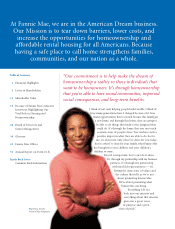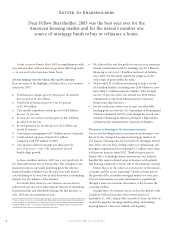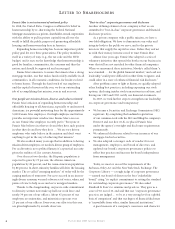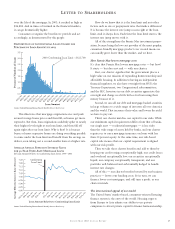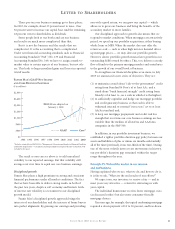Fannie Mae 2003 Annual Report Download - page 12
Download and view the complete annual report
Please find page 12 of the 2003 Fannie Mae annual report below. You can navigate through the pages in the report by either clicking on the pages listed below, or by using the keyword search tool below to find specific information within the annual report.
10 FANNIE MAE 2003 ANNUAL REPORT
payment mortgages were considered too risky. But then we
helped to standardize the 3 to 5 percent down payment loan,
brought it to global capital markets, and made it available
to lenders and communities nationwide. Now low-down
payment loans are commonplace. And we just adopted a new
variance in our underwriting standards that will make the
$500 down payment loan widely available as well.
Our market leadership in mortgage technology also brings
real benefit to the consumer. For example, by standardizing
our automated underwriting technology and making it
available to lenders nationwide, we have cut the typical loan
application approval process down to a few minutes and
cut approximately $1,000 off the loan origination cost. That
$1,000 savings is equivalent to a huge down payment assistance
program. This technology also helps smaller lenders to offer
big-bank mortgage services without the big-bank overhead,
expanding competition in the mortgage industry.
Bringing capital to where it would not go by itself
One of the greatest benefits of America’s secondary mortgage
market is its ability to pull housing capital into underserved
communities. By working with a wide range of lenders
and housing partners, Fannie Mae helps bring low-cost,
consumer-friendly financing to people and places where it
would not go by itself.
In 1994, we pledged to provide $1 trillion in capital to ten
million underserved families by the end of 2000. Thanks to
our housing and industry partners, we met that goal early.
Then in 2000, we launched our American Dream
Commitment, a pledge to provide $2 trillion in capital to
18 million underserved families by the year 2010, including
$400 billion targeted specifically for minority families (later
raised to $700 billion in response to President Bush’s
Minority Homeownership Initiative).
After four of the strongest years in housing and mortgage
finance history, we’ve already surpassed the top-line goals of
this commitment. But our work is far from complete.
So in January 2004, we announced our Expanded American
Dream Commitment and pledged significant new resources
to tackle America’s toughest housing challenges. Our new
commitment has three main goals.
First, we will expand access to homeownership for six
million first-time home buyers in the next ten years, including
1.8 million minority first-time home buyers. We also will
help raise the national minority homeownership rate from
49 percent to 55 percent, with the ultimate goal of closing
it entirely.
Second, we will help new and long-term homeowners
stay in their homes through a series of initiatives, and
commit $15 billion to preserve affordable rental housing and
$1.5 billion to support the revitalization of public housing
communities.
Third, we will increase the supply of affordable housing
and support community development activities in at least
1,000 neighborhoods across the country through our
American Communities Fund, and through targeted investments
like Low-Income Housing Tax Credits that help finance
affordable rental housing.
It is because of initiatives like our Trillion Dollar
Commitment and our American Dream Commitment that
we have exceeded our HUD affordable housing goals for ten
consecutive years. And we have increased our financing of
mortgages to African Americans by over 400 percent and to
Hispanic Americans by 470 percent in the past ten years,
compared with a 205 percent increase in overall financing.
Our Expanded American Dream Commitment will help us
do even more.
That leads to the last question in this discussion: “Why is
what Fannie Mae does still important?”
Principle V: As the American Dream grows, so do we
Some economists have questioned whether the American Dream
needs to grow anymore. They suggest that our nation is over-
invested in housing. And they ask whether Fannie Mae’s role
in expanding homeownership is needed anymore.
The fact is, the demand for housing capital continues to
grow because this country continues to grow. Based on census
data, we project there will be 30 million more Americans by
the end of the decade, both immigrants and native-born.
Applying headship rates — that is, the rate at which population
creates households — those 30 million Americans will create
13 to 15 million new households that will need a place to
LETTER TO SHAREHOLDERS
Fannie Mae’s disciplined growth approach brings the interests of our shareholders
and the interests of home buyers into perfect alignment. By growing our earnings and
providing you with a good return, we can grow our capital — which allows us to grow
our business and bring the benefits of the secondary market to more families.


